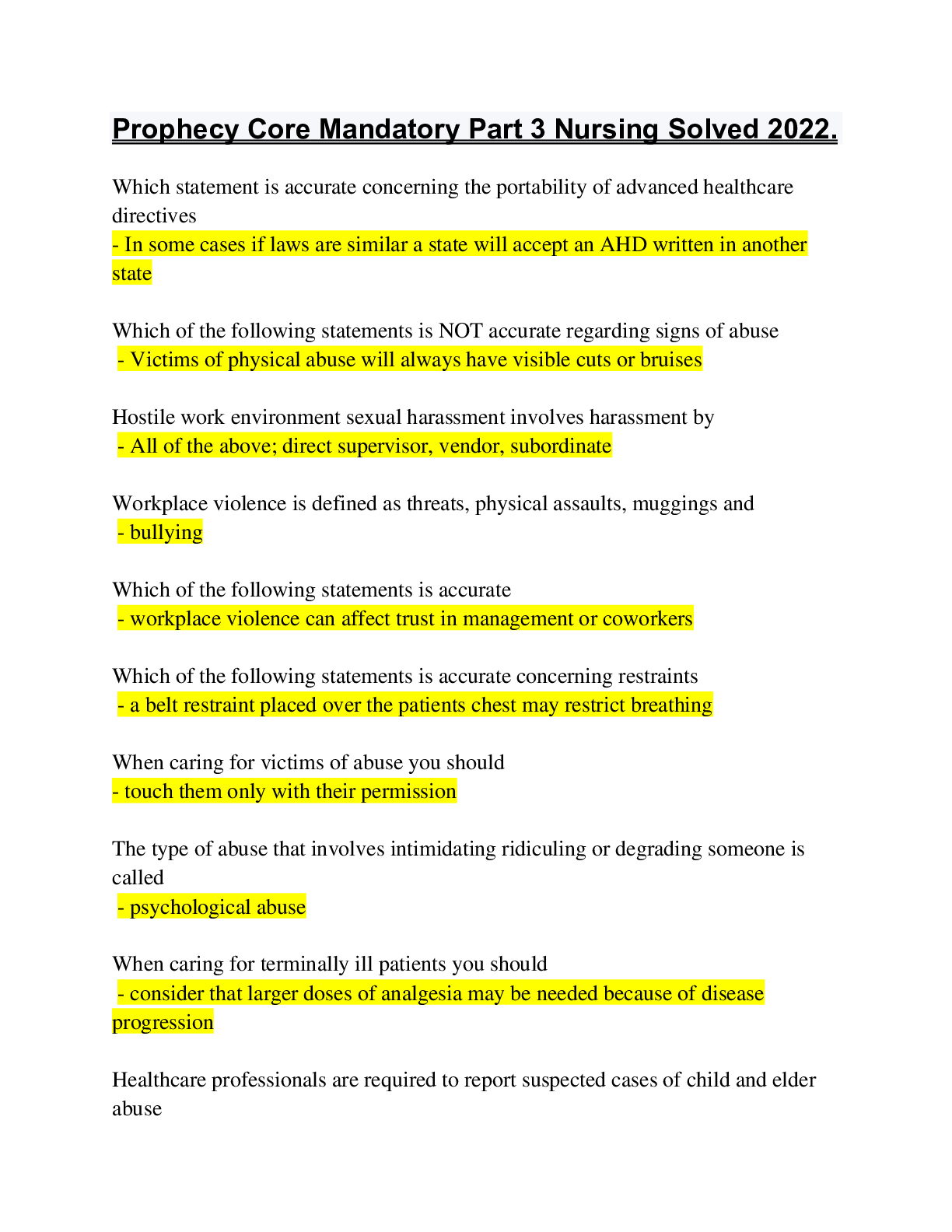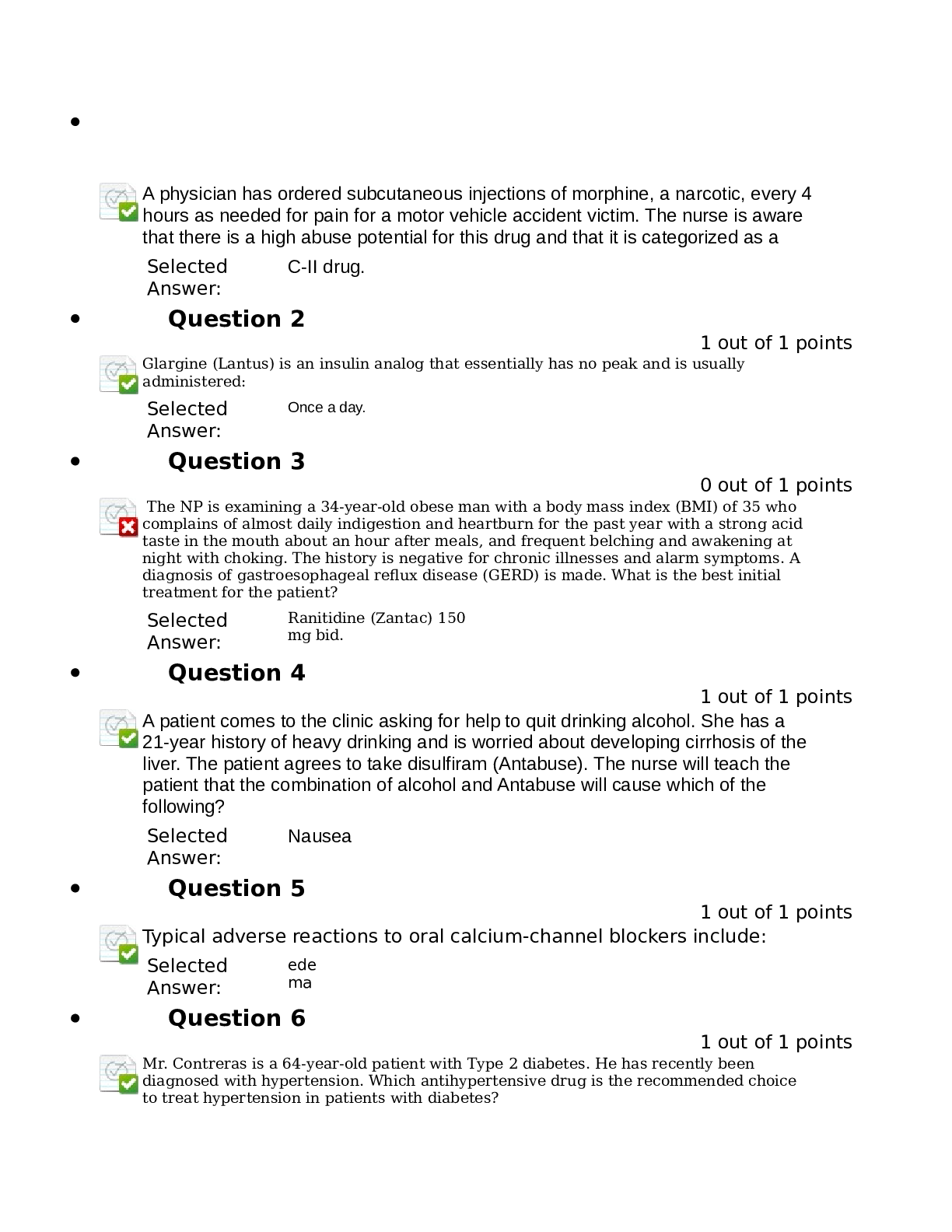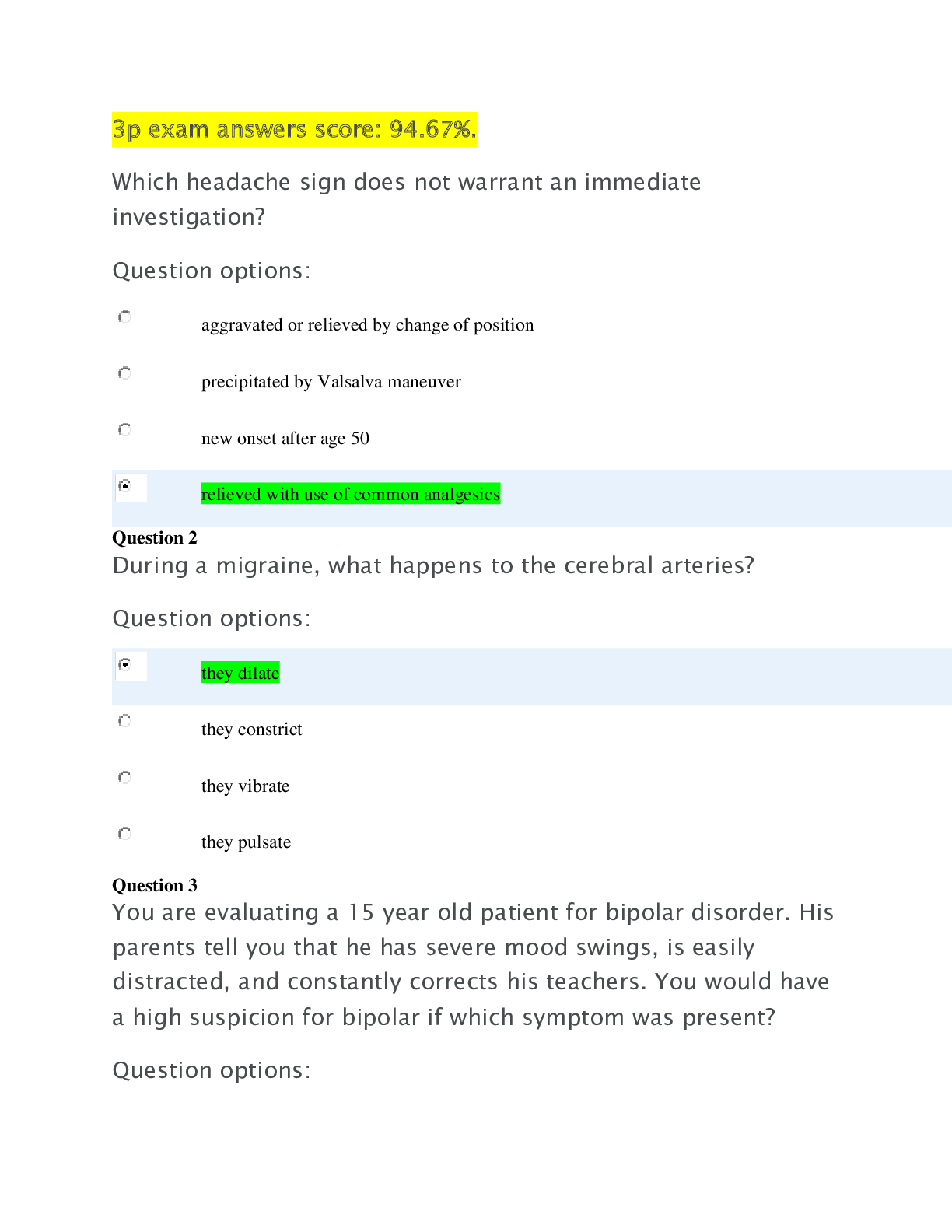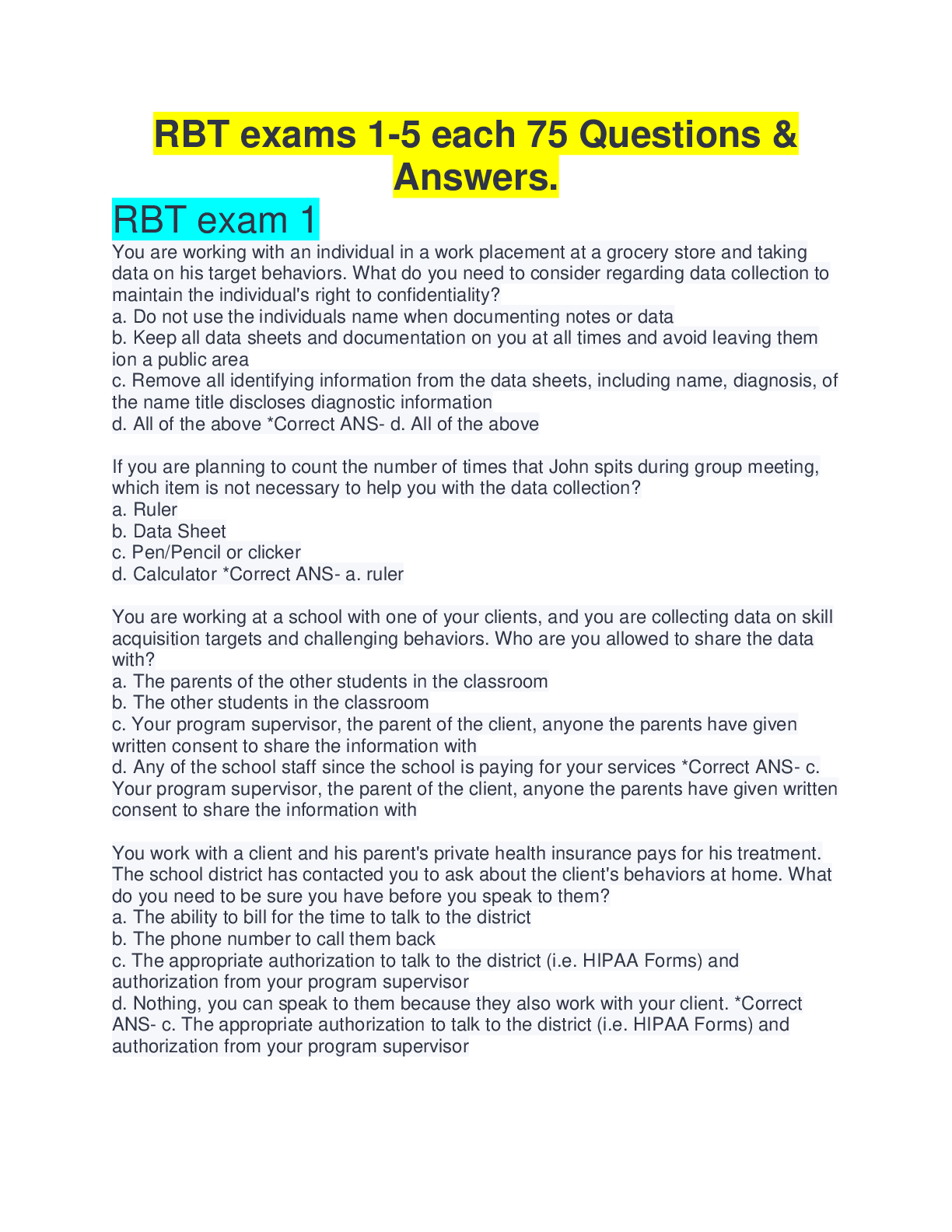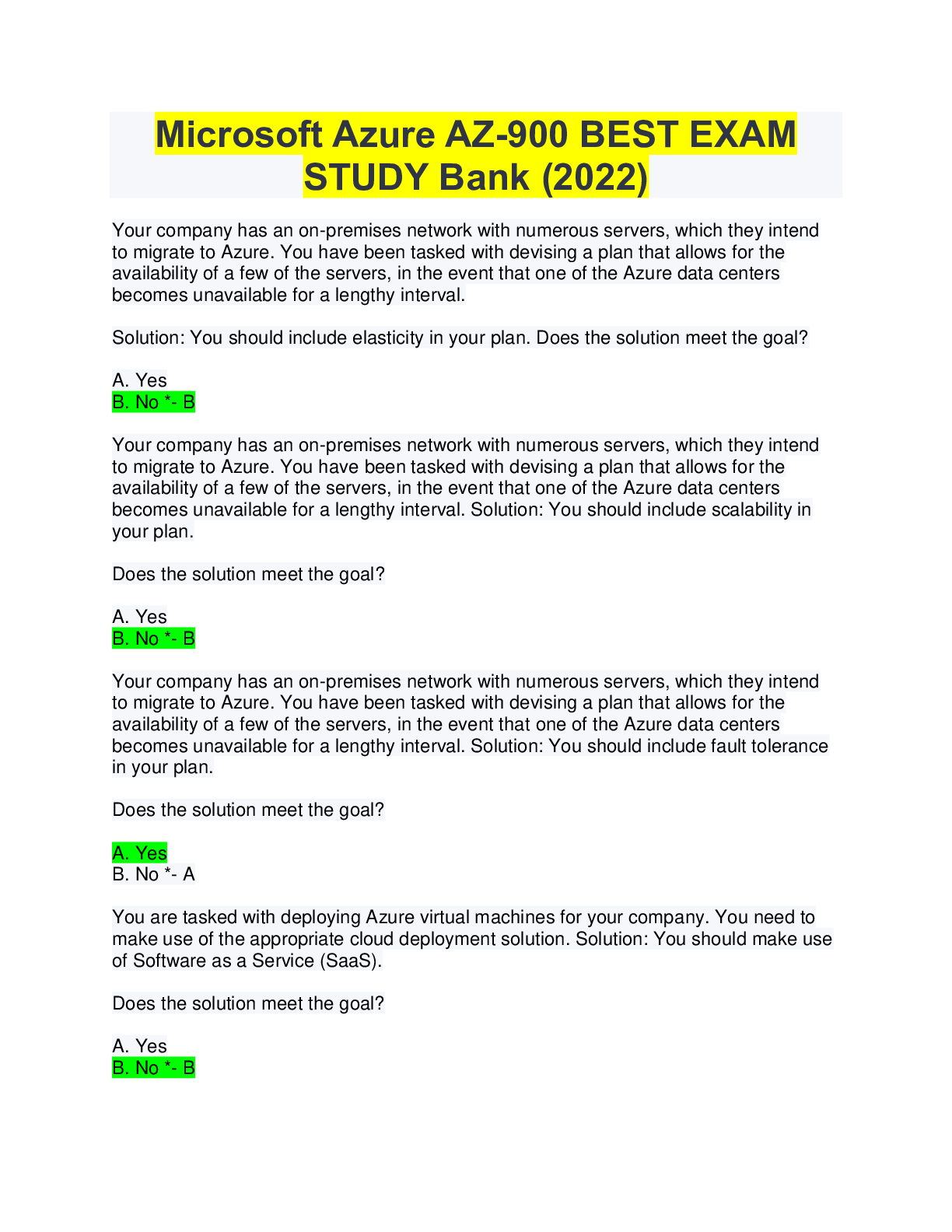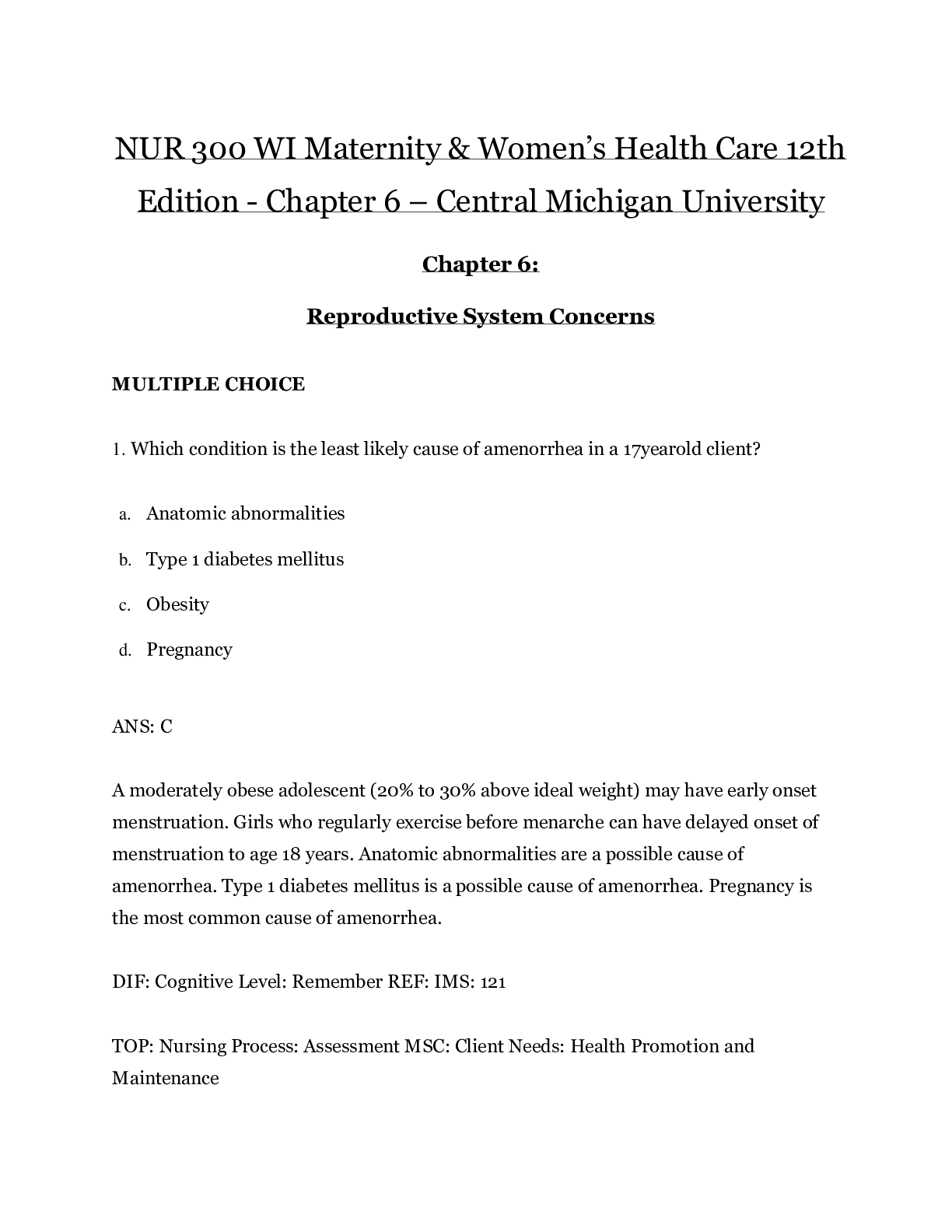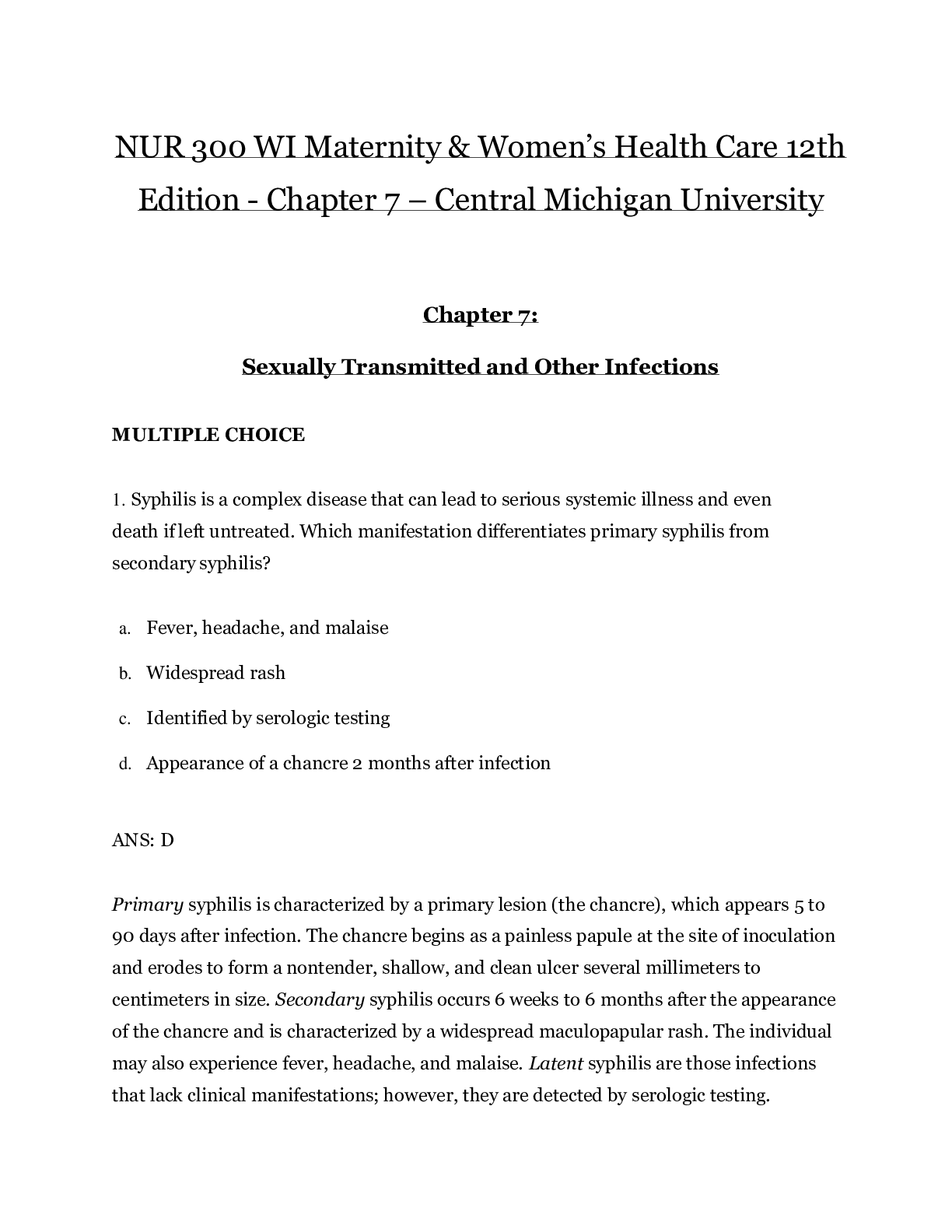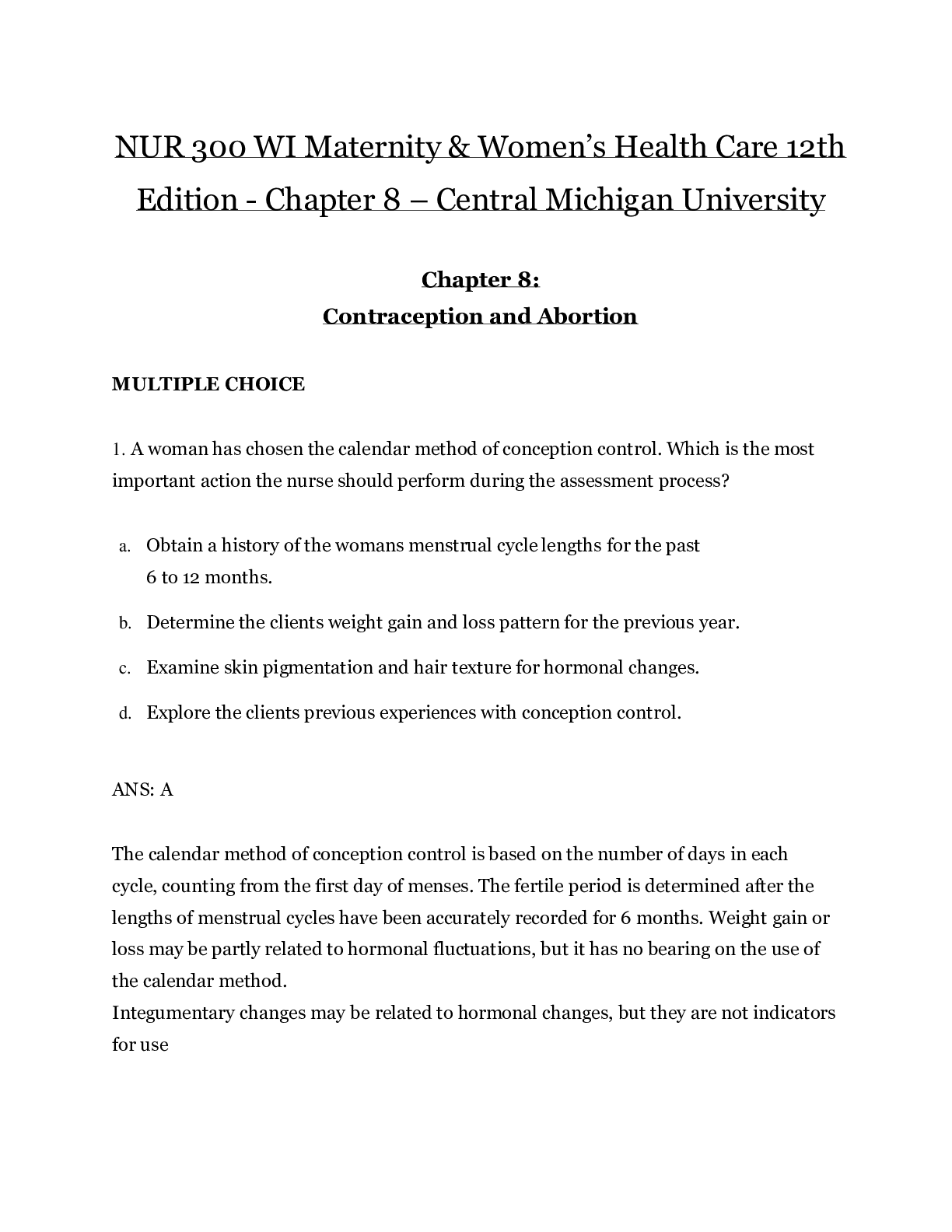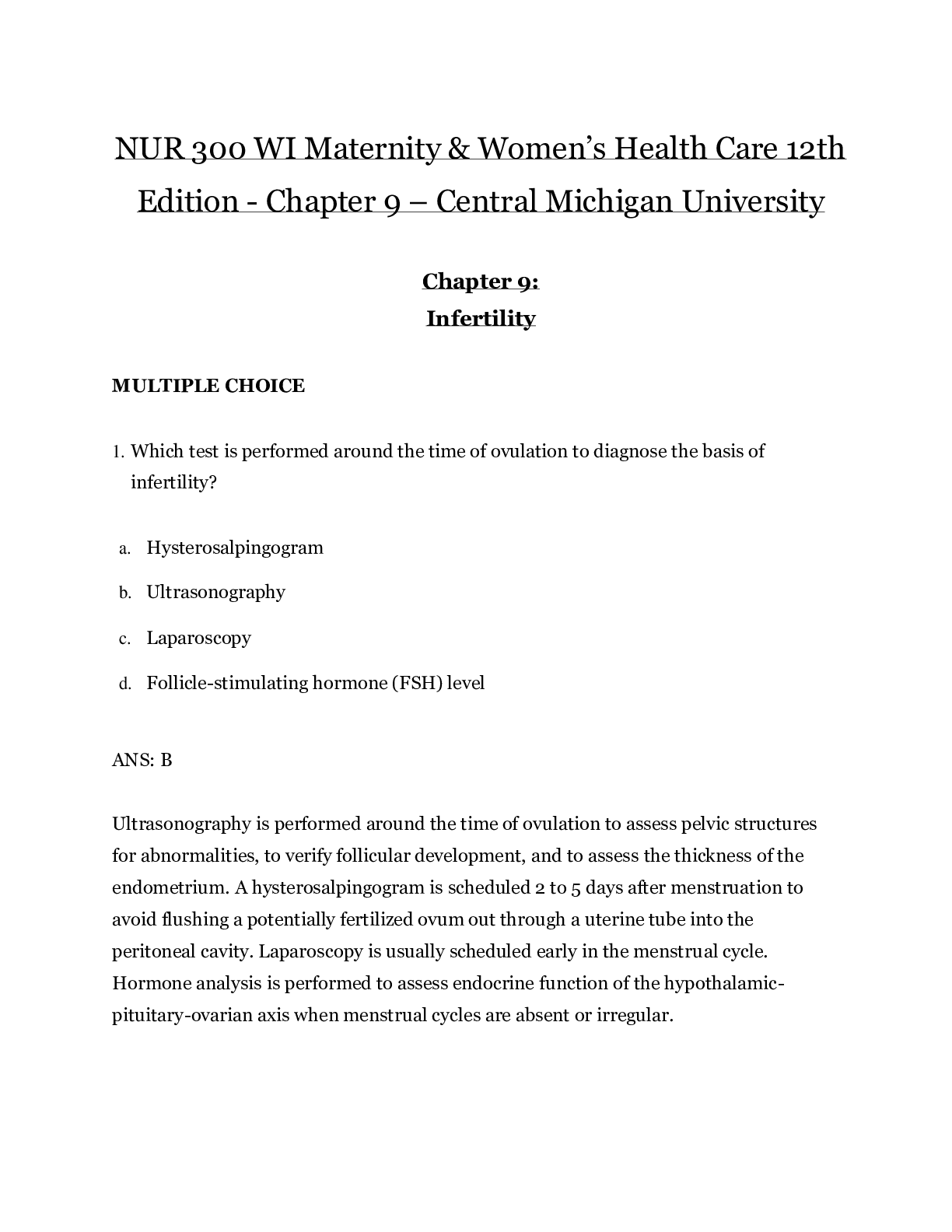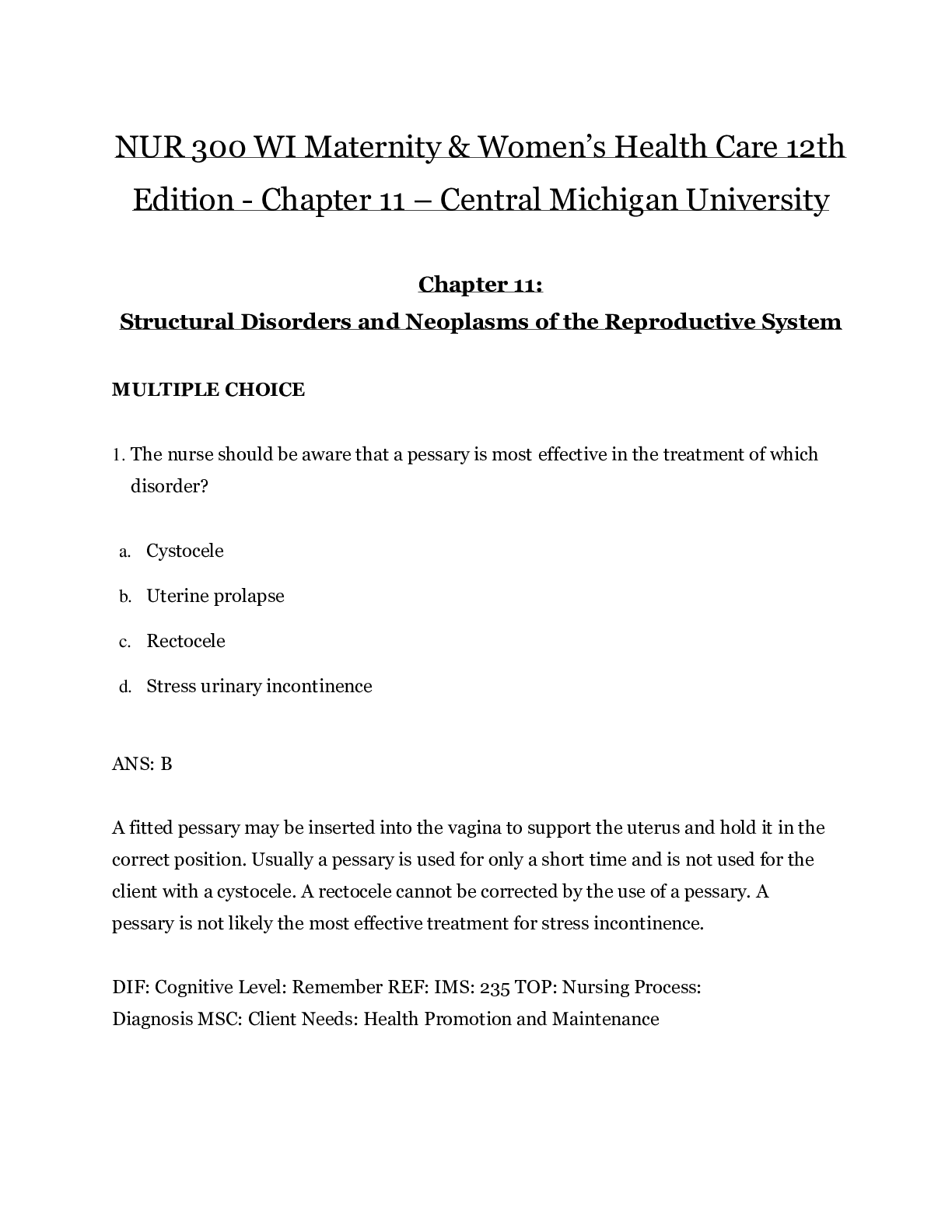*NURSING > EXAM > Chapter 11: Structural Disorders and Neoplasms of the Reproductive System Lowdermilk: Maternity & Wo (All)
Chapter 11: Structural Disorders and Neoplasms of the Reproductive System Lowdermilk: Maternity & Women’s Health Care, 12th Edition
Document Content and Description Below
1. The nurse should be aware that a pessary is most effective in the treatment of which disorder? 2. A postmenopausal woman has been diagnosed with two leiomyomas (fibroids). Which clinical finding... is most commonly associated with the presence of leiomyomas? 3. Which woman is at the greatest risk for psychologic complications after hysterectomy? 4. A 48-year-old woman has just had a hysterectomy for endometrial cancer. Which statement alerts the nurse that further teaching is needed? 5. Considering the treatment plan for a pregnant woman with gynecologic cancer, which statement about timing or type of treatment is correct? TOP: Nursing Process: Planning MSC: Client Needs: Health Promotion and Maintenance 6. Which precaution should the nurse take while caring for a client who is undergoing internal radiation therapy for cervical cancer? a. Wear gloves when assessing the cervical intracavity implant. b. Instruct the client to urinate in the lead-lined bedpan or “hat” every 2 hours. c. Prepare the client for an enema before inserting the implant. d. Limit staff or visitor exposure to 30 minutes or less in an 8-hour period. ANS: D Staff and visitor exposure should be limited to 30 minutes or less in an 8-hour period to reduce the risk of overexposure to radiation. Nurses need to protect themselves from overexposure to radiation. Wearing a shield is one method of protection. An indwelling catheter is inserted to prevent urinary distention that could dislodge the applicator. No bowel preparation is necessary. PTS: 1 DIF: Cognitive Level: Apply TOP: Nursing Process: Implementation MSC: Client Needs: Safe and Effective Care Environment 7. Which nursing diagnosis fails to address the psychologic effect of these disorders of a client diagnosed with a neoplasm of the reproductive system? a. Anxiety related to surgical procedures b. Reduced self-concept, resulting from changes in anatomy c. Potential for injury, related to lack of skill for self-care d. Inadequate family procNesUseRs SINGTB.COM ANS: C Although potential for injury, related to lack of skill for self-care, is appropriate to this client’s condition, this diagnosis is more suited to the client’s learning needs than the psychologic effect. Anxiety, related to surgical procedures, is appropriate for addressing psychosocial concerns; the client may also develop anxiety related to the diagnosis and prognosis and whether or not surgery is required. Reduced self-concept is an applicable diagnosis; changes in her anatomy and function may also result in low self-esteem and ineffective coping skills. Inadequate family processes is a possible and acceptable diagnosis; functional and anatomic changes may result in the client’s inability to fulfill her familial role. Depending on the severity of her condition, inadequate family processes could also lead to social isolation. PTS: 1 DIF: Cognitive Level: Analyze TOP: Nursing Process: Diagnosis MSC: Client Needs: Psychosocial Integrity 8. Which of these interventions should the nurse instruct the client diagnosed with urinary incontinence (UI) to use first? a. Pelvic floor support devices b. Pelvic muscle exercises c. Surgery d. Medications ANS: B Pelvic muscle exercises, known as Kegel exercises, along with bladder training can significantly decrease or entirely relieve stress incontinence in many women. Pelvic floor support devices, also known as pessaries, come in a variety of shapes and sizes. Pessaries may not be effective for all women and require scrupulous cleaning to prevent infection. Anterior and posterior repairs and even a hysterectomy may be performed. If surgical repair is performed, then the nurse must focus her care on preventing infection and helping the woman avoid putting stress on the surgical site. Pharmacologic therapy includes selective serotonin-norepinephrine reuptake inhibitors or vaginal estrogen therapy. However, pharmacologic therapy is not the first action a nurse should recommend. PTS: 1 DIF: Cognitive Level: Apply TOP: Nursing Process: Implementation MSC: Client Needs: Physiologic Integrity 9. What information is important for the nurse to include in planning for the care of a woman who has had a vaginal hysterectomy? a. Expect to be fully recovered in 4 to 6 weeks. b. Expect no changes in hormone levels. c. Expect surgical menopause. d. Take tub baths to aid in healing. ANS: B Unless the ovaries were also removed, hormonal levels should not change. Menses will cease, but the hypothalamus-pituitary-ovarian axis remains intact. The woman should expect to have vaginal discharge for 4 to 6 weeks. Full recovery varies from woman to woman, depending on risk factors and individual healing. Surgical menopause occurs only if the ovaries are also removed. TNhe RclieInt shGoulBd.avCoidMtub baths, intercourse, and douching until after the follow-up examination. PTS: 1 DIF: Cognitive Level: Applying TOP: Nursing Process: Planning MSC: Client Needs: Physiologic Integrity 10. A woman has preinvasive cancer of the cervix. Which modality would the nurse discuss as an available option for a client with this condition? a. Cryosurgery b. Colposcopy c. Hysterectomy d. Internal radiation ANS: A Cryosurgery, laser surgery, and loop electrosurgical excision procedure (LEEP) are several techniques used to treat preinvasive lesions. Colposcopy is the examination of the cervix with a stereoscopic binocular microscope that magnifies the view of the cervix. This examination would have already been performed as part of the diagnosis of preinvasive cancer of the cervix. A hysterectomy is performed if the cancer has extended beyond the cervix. Women with positive pelvic nodes (indicating invasive cancer) usually receive whole pelvis irradiation. PTS: 1 DIF: Cognitive Level: Apply TOP: Nursing Process: Planning MSC: Client Needs: Physiologic Integrity 11. Which condition is the most common malignancy of the reproductive system? a. Endometrial cancer b. Cervical cancer c. Ovarian cancer d. Vulvar and vaginal cancer ANS: A Endometrial cancer occurs most frequently in Caucasian women and after menopause. Certain viral infections and sexually transmitted diseases (STIs) create risks for cervical cancer. Ovarian cancer is the most malignant reproductive system cancer and accounts for the most deaths. Cancers of the vulva and vagina are relatively rare. PTS: 1 DIF: Cognitive Level: Remember TOP: Nursing Process: Assessment MSC: Client Needs: Health Promotion and Maintenance 12. A client in late middle age who is certain she is not pregnant tells the nurse during an office visit that she has urinary problems, as well as sensations of bearing down and of something in her vagina. What condition would the nurse suspect based upon this report? a. Pelvic relaxation b. Cystocele c. Uterine prolapse d. Genital fistulas ANS: B Uterine displacement can be caused by congenital or acquired weakness of the pelvic support structures and is knoUwn Sas pNelviTc relaxaOtion. Cystoceles are protrusions of the bladder downward into the vagina; rectoceles are herniations of the anterior rectal wall through a relaxed or ruptured vaginal fascia. Both can produce a bearing-down sensation with urinary dysfunction. They occur more often in older women who have borne children. Uterine prolapse is a more serious type of displacement. In women with a complete prolapse, the cervix and body of the uterus protrude through the vagina. Genital fistulas are perforations between genital tract organs. Most occur between the bladder and the genital tract. PTS: 1 DIF: Cognitive Level: Analyze TOP: Nursing Process: Diagnosis MSC: Client Needs: Health Promotion and Maintenance 13. Which woman has the highest risk for endometrial cancer? a. Postmenopausal woman with hypertension b. Woman who has an intrauterine device (IUD) c. Client who has been on birth control for 15 years d. Perimenopausal woman who has a cystocele ANS: A Endometrial cancer is most often seen in postmenopausal women between the ages of 50 and 65 years. Hypertension is a risk factor associated with the development of this malignancy. The use of an IUD does not increase a woman’s risk for endometrial cancer. A client who has been on birth control for 15 years is not at increased risk for endometrial cancer; the birth control contraceptives might offer some protection. The development of a cystocele will not increase a woman’s risk for endometrial cancer. PTS: 1 DIF: Cognitive Level: Analyzing TOP: Nursing Process: Assessment MSC: Client Needs: Health Promotion and Maintenance 14. A myomectomy is a procedure prescribed for symptom relief of what condition? a. Numerous small fibroid tumors b. Bartholin cysts c. Fibroid tumors near the outer wall of the uterus with a uterine size no larger than at 12 weeks of gestation d. Leiomyomas in a uterus larger than 14 weeks of gestation ANS: C If a fibroid tumor lies near the outer wall of the uterus and the uterine size is no larger than at 12 to 14 weeks of gestation and the symptoms are significant, a myomectomy (i.e., removal of the tumor) may be performed. This procedure leaves the uterine walls relatively intact, thereby preserving the uterus for future pregnancies. Laser surgery or electrocauterization can be safely used to destroy numerous small fibroid tumors. Bartholin cysts are benign lesions of the vulva. If the cyst is symptomatic or infected, surgical incision and drainage may provide relief. A hysterectomy (i.e., removal of the entire uterus) is the treatment of choice if bleedNingRis sIeveGre oBr i.f tChe fMibroid tumor is obstructing the normal function of other organs. PTS: 1 DIF: Cognitive Level: Understand TOP: Nursing Process: Assessment MSC: Client Needs: Physiologic Integrity 15. Which ovarian neoplasm is described as a growth that contains hair, teeth, and sebaceous secretions? a. Ovarian fibroma b. Dermoid cyst c. Uterine polyp d. Follicular cyst ANS: B Dermoid cysts are germ cell tumors, usually occurring in childhood, that may contain teeth, hair, bones, and sebaceous secretions and may unilaterally or bilaterally develop. Treatment is most often surgical removal. An ovarian fibroma is a solid ovarian neoplasm that develops from connective tissue, usually after menopause. A uterine polyp is a tumor that grows on the uterine wall on a stalk or pedicle. A follicular cyst develops within the ovaries of young women in response to follicle rupture and should resolve within one or two menstrual cycles. PTS: 1 DIF: Cognitive Level: Remember TOP: Nursing Process: Assessment MSC: Client Needs: Health Promotion and Maintenance MULTIPLE RESPONSE 1. The client is undergoing treatment for ovarian cancer. Which common nutritional problems are related to gynecologic cancers and the treatment thereof? (Select all that apply.) a. Stomatitis b. Constipation c. Increased appetite d. Diarrhea e. Nausea and vomiting ANS: A, B, D, E Altered taste, stomatitis, constipation, anorexia, diarrhea, and nausea and vomiting are all possible nutritional complications related to gynecologic cancers and their treatment. The nurse must assess accordingly and adapt the client’s plan of care. To ensure recovery, these women should consume a diet high in iron and protein, drink plenty of fluids, and eat foods high in vitamins C, B, and K. PTS: 1 DIF: Cognitive Level: Apply TOP: Nursing Process: Assessment | Nursing Process: Planning MSC: Client Needs: Health Promotion and Maintenance 2. Leiomyomas are benign tumors arising from the muscle tissue of the uterus. Which information related to these tumors is accurate? (Select all that apply.) a. Are rapid growing NURSINGTB.COM b. Are more common in African-American women c. Are more common in women who have never been pregnant d. Obesity is a risk factor with leiomyomas e. Become malignant if left untreated ANS: B, C, D The exact cause of leiomyomas remains unknown, although genetic factors may be involved in their development. Most are found in the body of uterus and are classified according to their location on the uterine wall. They are benign, slow growing, and often spontaneously shrink after menopause. PTS: 1 DIF: Cognitive Level: Understand TOP: Nursing Process: Assessment MSC: Client Needs: Health Promotion and Maintenance 3. The client has undergone hysteroscopic uterine ablation to destroy several smaller fibroids. The nurse is preparing to provide discharge instructions. Which information is a priority for the patient and should be included in the teaching plan? (Select all that apply.) a. Analgesics and nonsteroidal antiinflammatory drugs can be used for pain control. b. Vaginal discharge is to be expected for 5 to 7 days. c. Sexual activity can be resumed after 48 hours. d. Next menstrual period will be irregular. e. Provider should be notified if heavy bleeding occurs. ANS: A, D, E Before discharging the client, the following information should be given: analgesics can be used for pain relief as needed, normal activities can be resumed within several days, vaginal discharge is to be expected for 4 to 6 weeks, and the use of tampons and sexual activity should be avoided for 2 weeks. The next menstrual period will be irregular, and the provider should be notified for heavy bleeding or signs of infection. PTS: 1 DIF: Cognitive Level: Apply TOP: Nursing Process: Implementation MSC: Client Needs: Health Promotion and Maintenance [Show More]
Last updated: 1 year ago
Preview 1 out of 8 pages
Instant download

Buy this document to get the full access instantly
Instant Download Access after purchase
Add to cartInstant download
Reviews( 0 )
Document information
Connected school, study & course
About the document
Uploaded On
Jul 10, 2021
Number of pages
8
Written in
Additional information
This document has been written for:
Uploaded
Jul 10, 2021
Downloads
0
Views
43


